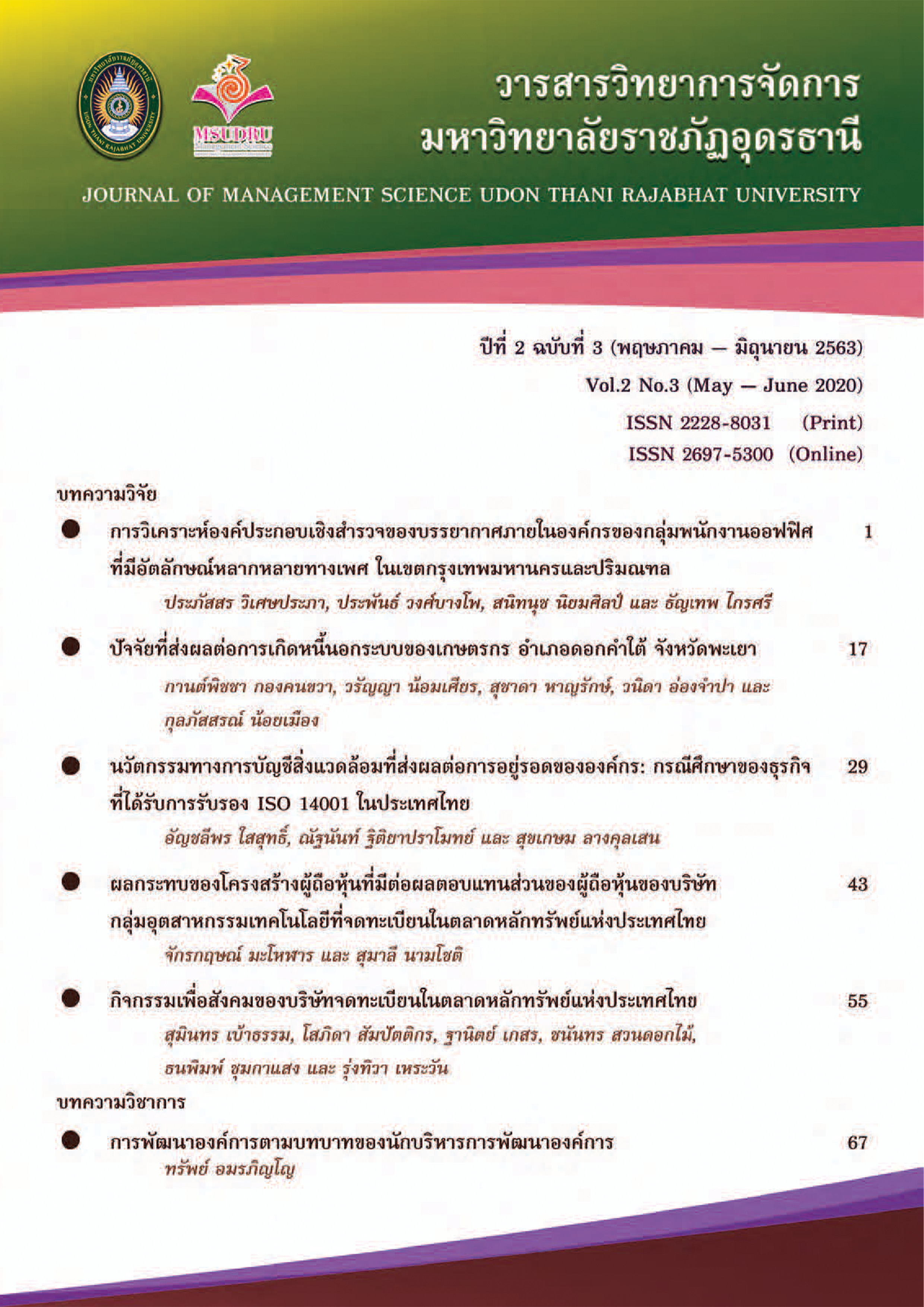FACTORS AFFECTING INFORMAL DEBT OF FARMERS IN DOKKHAMTAI, PHAYAO
Main Article Content
Abstract
The objective of this research was to empirically investigate factors affecting the informal debt among farmers in Dokkhamtai, Phayao. To achieve research objective, the researchers used a questionnaire survey and conducted from 374 farmers selected by convenience sampling. Statistical methods used were descriptive statistics: frequency, percentage, mean, standard deviation; and inference statistic: multiple regression analysis. The empirical evidence from the multiple regression analysis could be summarized as follows. 1) Gender and number of household members, appeared to be an effect on informal debt. 2) Variability in agricultural income, non-farm income, and agricultural expenses played an important role in explaining the changing of informal debt. 3) Economic situation, members of household, persons outside household and technology development provided sufficient evidence that affecting informal debt.
Article Details

This work is licensed under a Creative Commons Attribution-NonCommercial-NoDerivatives 4.0 International License.
บทความที่ได้รับการตีพิมพ์เป็นลิขสิทธิ์ของคณะวิทยาการจัดการ มหาวิทยาลัยราชภัฏอุดรธานี
ข้อความที่ปรากฏในบทความแต่ละเรื่องในวารสารวิชาการเล่มนี้ ไม่ใช่ความคิดเห็นและความรับผิดชอบของผู้จัดทำ บรรณาธิการ กองบรรณาธิการ และคณะวิทยาการจัดการ มหาวิทยาลัยราชภัฏอุดรธานี ความรับผิดชอบด้านเนื้อหาและการตรวจร่างบทความแต่ละเรื่องเป็นความคิดเห็นของผู้เขียนบทความแต่ละท่าน
References
กรมส่งเสริมการเกษตร. (2561). จำนวนเกษตรกรในอำเภอดอกคำใต้ จังหวัดพะเยา. สืบค้นเมื่อ 2 ธันวาคม 2562, จาก https://www.doae.go.th/index.php
กัลยา วานิชย์บัญชา. (2556). การวิเคราะห์สมการโครงสร้าง (SEM) ด้วย AMOS. กรุงเทพฯ: สามลดา.
ชฎาภรณ์ ณ นคร. (2558). ปัจจัยที่มีผลต่อการเกิดหนี้นอกระบบในครัวเรือนของประชากรในเขตเทศบาลเมืองปากพูน อำเภอเมือง จังหวัดนครศรีธรรมราช. การค้นคว้าอิสระ ปริญญาเศรษฐศาสตรมหาบัณฑิต มหาวิทยาลัยหอการค้าไทย.
ฐานิตา มีลา. (2556). ปัจจัยที่ส่งผลต่อการเป็นหนี้นอกระบบของชาวนา ในเขตอำเภอปากท่อ จังหวัดราชบุรี. วิทยานิพนธ์ ปริญญาบริหารธุรกิจมหาบัณฑิต มหาวิทยาลัยศิลปากร.
ณัชพงษ์ สำราญ. (2560). มาตรการทางกฎหมายในการปรับโครงสร้างหนี้ภาคประชาชน: ศึกษากรณีหนี้นอกระบบ. วารสารวิชาการมหาวิทยาลัยหอการค้าไทย มนุษยศาสตร์และสังคมศาสตร์, 37(1), 91- 101.
ธีรวีร์ วราธรไพบูลย์. (2557). พฤติกรรมการบริโภค: อาหารนิยมบริโภคกับอาหารเพื่อสุขภาพ. วารสารปัญญาภิวัฒน์, 5(2), 255- 264.
ปิยะลักษณ์ พุทธวงศ์, ศศิเพ็ญ พวงสายใจ, ไพรัช กาญจนการุณ, วรลักษณ์ หิมะกลัส, สุชาติ พรหมขัติแก้ว, สุขุม พันธุ์ณรงค์ และ พิมลพรรณ บุญยะเสนา. (2559). หนี้นอกระบบ: ปัญหาและแนวทางแก้ไขภายใต้แนวทางปรัชญาเศรษฐกิจพอเพียง. วารสารเศรษฐศาสตร์ มหาวิทยาลัยเชียงใหม่, 20(1), 1- 22.
แพทรียา หงสุวรรณ์ และ ปิยะพงษ์ บุษบงก์. (2561). กระบวนการจัดการธุรกิจเงินกู้นอกระบบในเขตเทศบาลเมืองมหาสารคาม จังหวัดมหาสารคาม. วารสารช่อพะยอม, 29(1), 173- 184.
สำนักงานสถิติแห่งชาติ. (2562). ข้อมูลทางการเงินของภาคการเกษตร. สืบค้นเมื่อ 5 ธันวาคม 2562, จาก http://www.nso.go.th/sites/2014en
อุษา อมรรัชยาวิจารณ์. (2560). ปัจจัยที่มีผลต่อการเกิดหนี้นอกระบบของประชาชน ในอำเภอเมืองชุมพร จังหวัดชุมพร. วารสารวิจัยและพัฒนา มหาวิทยาลัยราชภัฏสวนสุนันทา, 9(1), 62-73.
Caudell, M., Rotolo, T., & Grima, M. (2015). Informal Lending Networks in Rural Ethiopia. Social Networks, 40(January), 34- 42.
Islam, A., Nguyen, C., & Smyth, R. (2015). Does Microfinance Change Informal Lending in Village Economies? Evidence from Bangladesh. Journal of Banking & Finance, 50(January), 141-156.
Krejcie, V. R., & Morgan, W. D. (1970). Determining Sample Size for Research Activities. Educational and Psychological Measurement, 30(3), 607- 610.
Madestam, A. (2014). Informal Finance: A Theory of Moneylenders. Journal of Development Economics, 107(March), 157-174.
Pham, T.T, & Lensink, R. (2007). Lending Policies of Informal, Formal and Semiformal Lenders: Evidence from Vietnam. Economics of Transition, 15(2), 181- 209.


